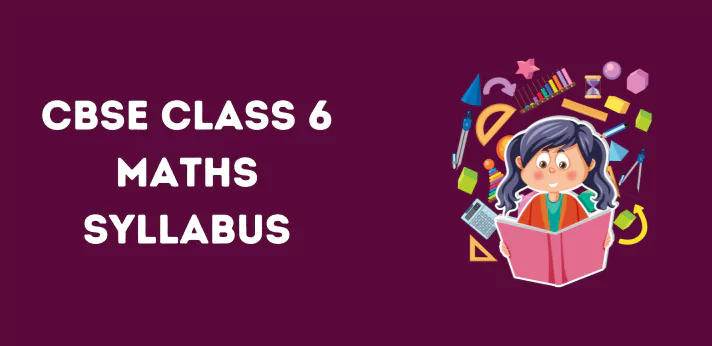The CBSE Class 6 Maths Syllabus for the academic session 2024-25 has been updated. Students are encouraged to review the revised syllabus recently uploaded to the website.
[Index]
Overview
Before delving into the Class 6 Maths NCERT Syllabus, reviewing the CBSE Class 6 Summary is recommended. The comprehensive CBSE Class 6 Summary is provided below for reference. Students are encouraged to explore it to gain a thorough understanding.
| Particulars | Description |
| Class | 6th |
| Board | CBSE |
| Subject | Maths |
| Category | Syllabus |
| Study Materials | Class 6 Study Materials |
| E-Book | Class 6 E-Book |
| Youtube Channel | Subscribe now |
CBSE Class 6 Maths Syllabus 2024-25 (New)
Understanding the Maths, Mathematical questions and other mathematical operations which is a concern for Class 6 Mathematics. Let us now discuss the CBSE Class 6 Maths syllabus with topics to be covered and the month assigned.
Class 6 Maths Ganita Parkash Syllabus (For Session 2024 Onwards)
| Chapter | Chapter Name |
| 1 | Patterns in Mathematics |
| 2 | Lines and Angles |
| 3 | Number Play |
| 4 | Data Handling and Presentation |
| 5 | Prime Time |
| 6 | Perimeter and Area |
| 7 | Fractions |
| 8 | Playing with Constructions |
| 9 | Symmetry |
| 10 | The Other Side of Zero |
Class 6 Maths Syllabus (Old)
| Chapter Name | Topic to be Covered |
| Chapter 1: Knowing Our Numbers | 1.1 Introduction 1.2 Comparing Numbers 1.3 Large Numbers in Practice 1.4 Using Brackets 1.5 Roman Numerals |
| Chapter 2: Whole Numbers | 2.1 Introduction 2.2 Whole Numbers 2.3 The Number Line 2.4 Properties Of Whole Numbers 2.5 Patterns in Whole Numbers |
| Chapter 3: Playing With Numbers | 3.1 Introduction 3.2 Factors and Multiples 3.3 Prime and Composite Numbers 3.4 Test For Divisibility Of Numbers 3.5 Common Factors and Common Multiples 3.6 Some More Divisibility Rules 3.7 Prime Factorisation 3.8 Highest Common Factor 3.9 Lowest Common Multiple 3.10 Some Problems on HCF and LCM |
| Chapter 4: Basic Geometrical Ideas | 4.1 Introduction 4.2 Points 4.3 A Line Segment 4.4 A-line 4.5 Intersecting Lines 4.6 Parallel Lines 4.7 Ray 4.8 Curves 4.9 Polygons 4.10 Angles 4.11 Triangles 4.12 Quadrilaterals 4.13 Circles |
| Chapter 5: Understanding Elementary Shapes | 5.1 Introduction 5.2 Measuring Line Segments 5.3 Angles-’Right’ and ‘Straight’ 5.4 Angles- ‘Acute’, ‘Obtuse’ and ‘Reflex’ 5.5 Measuring Angles 5.6 Perpendicular Lines 5.7 Classification of Triangles 5.8 Quadrilaterals 5.9 Polygons 5.10 Three Dimensional Shapes |
| Chapter 6: Integers | 6.1 Introduction 6.2 Integers 6.3 Addition of Integers 6.4 Subtraction of Integers with the help of a Number Line |
| Chapter 7: Fractions | 7.1 Introduction 7.2 A Fraction 7.3 Fraction on the Number Line 7.4 Proper Fractions 7.5 Improper and Mixed Fractions 7.6 Equivalent Fractions 7.7 Simplest Form of a Fraction 7.8 Like Fractions 7.9 Comparing Fractions 7.10 Addition and Subtraction of Fractions |
| Chapter 8: Decimals | 8.1 Introduction 8.2 Tenths 8.3 Hundredths 8.4 Comparing Decimals 8.5 Using Decimals 8.6 Addition of Numbers with Decimals 8.7 Subtraction of Decimals |
| Chapter 9: Data Handling | 9.1 Introduction 9.2 Recording Data 9.3 Organisation of Data 9.4 Pictograph 9.5 Interpretation of a Pictograph 9.6 Drawing a Pictograph 9.7 A Bar Graph |
| Chapter 10: Mensuration | 10.1 Introduction 10.2 Perimeter 10.3 Area |
| Chapter 11: Algebra | 11.1 Introduction 11.2 Matchstick Patterns 11.3 The Idea Of A Variable 11.4 More Matchstick Patterns 11.5 More Examples of Variables 11.6 Use Of Variables in Common Rules 11.7 Expressions with Variables 11.8 Using Expressions Practically 11.9 What is an Equation? 11.10 Solution of an Equation |
| Chapter 12: Ratio and Proportion | 12.1 Introduction 12.2 Ratio 12.3 Proportion 12.4 Unitary Method |
Class 6 Study Material
We have tried to bring CBSE Class 6 NCERT Study Materials like Syllabus, Worksheet, Sample Paper, NCERT Solutions, Important Books, Holiday Homework, Previous Year Question Papers etc. You can visit all these important topics by clicking the links given.
